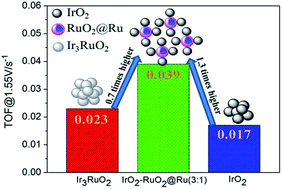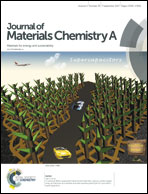Discontinuously covered IrO2–RuO2@Ru electrocatalysts for the oxygen evolution reaction: how high activity and long-term durability can be simultaneously realized in the synergistic and hybrid nano-structure†
Abstract
Here, we present our effort in simultaneously enhancing the intrinsic activity and improving the durability of catalysts based on Ir and Ru oxides. Through successful design and fabrication of the discontinuously covered IrO2–RuO2@Ru (3 : 1) supported structure, we are able to combine the high activity of RuO2 and the outstanding stability of IrO2. Specifically, the overpotential of the IrO2–RuO2@Ru (3 : 1) catalyst at 10 mA cm−2 is only 281 mV, and the turnover frequency (TOF) values of IrO2–RuO2@Ru (3 : 1), Ir3RuO2 and IrO2 catalysts are ca. 0.039, 0.023 and 0.017 s−1 at 1.55 V, respectively, indicating that IrO2–RuO2@Ru (3 : 1) exhibits higher intrinsic activity and the active surface sites possess greater ability to generate oxygen. The excellent durability of the IrO2–RuO2@Ru (3 : 1) catalyst is confirmed with the overpotential at 10 mA cm−2 positively shifting by only 16 mV after 3000 cycles through accelerated durability tests. Remarkably, the IrO2–RuO2@Ru (3 : 1) catalyst exhibits a huge advantage in reducing the use of precious metals in water electrolysis. Hence, the supported iridium–ruthenium bimetallic oxides show huge potential towards an active and stable application for the oxygen evolution reaction in acidic media.



 Please wait while we load your content...
Please wait while we load your content...